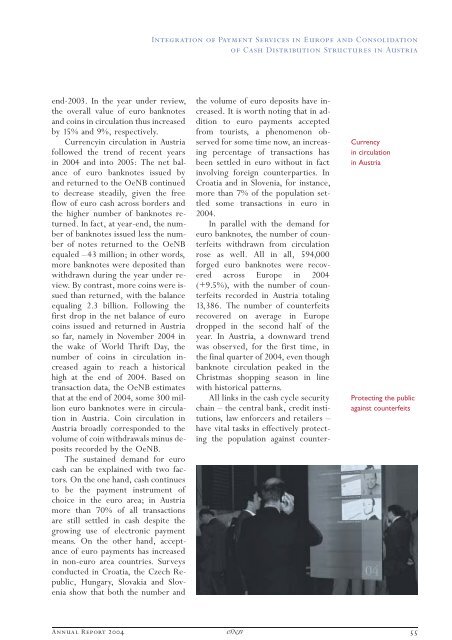You also want an ePaper? Increase the reach of your titles
YUMPU automatically turns print PDFs into web optimized ePapers that Google loves.
end-2003. In the year under review,<br />
the overall value of euro banknotes<br />
and coins in circulation thus increased<br />
by 15% and 9%, respectively.<br />
Currencyin circulation in Austria<br />
followed the trend of recent years<br />
in <strong>2004</strong> and into 2005: The net balance<br />
of euro banknotes issued by<br />
and returned to the OeNB continued<br />
to decrease steadily, given the free<br />
flow of euro cash across borders and<br />
the higher number of banknotes returned.<br />
In fact, at year-end, the number<br />
of banknotes issued less the number<br />
of notes returned to the OeNB<br />
equaled —43 million; in other words,<br />
more banknotes were deposited than<br />
withdrawn during the year under review.<br />
By contrast, more coins were issued<br />
than returned, with the balance<br />
equaling 2.3 billion. Following the<br />
firstdropinthenetbalanceofeuro<br />
coinsissuedandreturnedinAustria<br />
so far, namely in November <strong>2004</strong> in<br />
the wake of World Thrift Day, the<br />
number of coins in circulation increased<br />
again to reach a historical<br />
high at the end of <strong>2004</strong>. Based on<br />
transaction data, the OeNB estimates<br />
that at the end of <strong>2004</strong>, some 300 million<br />
euro banknotes were in circulation<br />
in Austria. Coin circulation in<br />
Austria broadly corresponded to the<br />
volume of coin withdrawals minus deposits<br />
recorded by the OeNB.<br />
The sustained demand for euro<br />
cash can be explained with two factors.<br />
On the one hand, cash continues<br />
to be the payment instrument of<br />
choice in the euro area; in Austria<br />
more than 70% of all transactions<br />
are still settled in cash despite the<br />
growing use of electronic payment<br />
means. On the other hand, acceptance<br />
of euro payments has increased<br />
in non-euro area countries. Surveys<br />
conductedinCroatia,theCzechRepublic,<br />
Hungary, Slovakia and Slovenia<br />
show that both the number and<br />
Integration of Payment Services in Europe and Consolidation<br />
of Cash Distribution Structures in Austria<br />
the volume of euro deposits have increased.<br />
It is worth noting that in addition<br />
to euro payments accepted<br />
from tourists, a phenomenon observedforsometimenow,anincreasing<br />
percentage of transactions has<br />
been settled in euro without in fact<br />
involving foreign counterparties. In<br />
Croatia and in Slovenia, for instance,<br />
more than 7% of the population settled<br />
some transactions in euro in<br />
<strong>2004</strong>.<br />
In parallel with the demand for<br />
euro banknotes, the number of counterfeits<br />
withdrawn from circulation<br />
rose as well. All in all, 594,000<br />
forged euro banknotes were recovered<br />
across Europe in <strong>2004</strong><br />
(+9.5%), with the number of counterfeits<br />
recorded in Austria totaling<br />
13,386. The number of counterfeits<br />
recovered on average in Europe<br />
dropped in the second half of the<br />
year. In Austria, a downward trend<br />
was observed, for the first time, in<br />
the final quarter of <strong>2004</strong>, even though<br />
banknote circulation peaked in the<br />
Christmas shopping season in line<br />
with historical patterns.<br />
All links in the cash cycle security<br />
chain — the central bank, credit institutions,<br />
law enforcers and retailers —<br />
have vital tasks in effectively protecting<br />
the population against counter-<br />
Currency<br />
in circulation<br />
in Austria<br />
Protecting the public<br />
against counterfeits<br />
<strong>Annual</strong> <strong>Report</strong> <strong>2004</strong> ×<br />
55
















